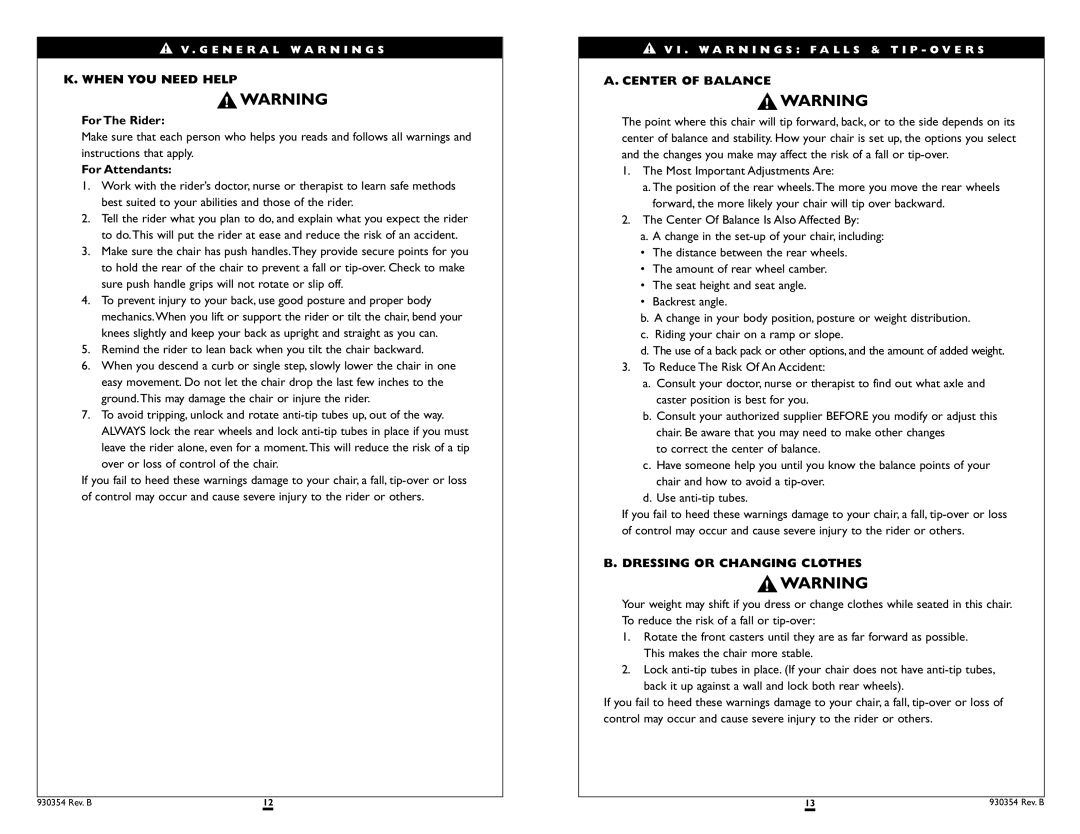
V . G E N E R A L W A R N I N G S
K. WHEN YOU NEED HELP
For The Rider:
Make sure that each person who helps you reads and follows all warnings and instructions that apply.
For Attendants:
1.Work with the rider’s doctor, nurse or therapist to learn safe methods best suited to your abilities and those of the rider.
2.Tell the rider what you plan to do, and explain what you expect the rider to do.This will put the rider at ease and reduce the risk of an accident.
3.Make sure the chair has push handles.They provide secure points for you to hold the rear of the chair to prevent a fall or
4.To prevent injury to your back, use good posture and proper body mechanics.When you lift or support the rider or tilt the chair, bend your knees slightly and keep your back as upright and straight as you can.
5.Remind the rider to lean back when you tilt the chair backward.
6.When you descend a curb or single step, slowly lower the chair in one easy movement. Do not let the chair drop the last few inches to the ground.This may damage the chair or injure the rider.
7.To avoid tripping, unlock and rotate
ALWAYS lock the rear wheels and lock
If you fail to heed these warnings damage to your chair, a fall,
930354 Rev. B | 12 |
V I . W A R N I N G S : F A L L S & T I P - O V E R S
A. CENTER OF BALANCE
The point where this chair will tip forward, back, or to the side depends on its center of balance and stability. How your chair is set up, the options you select and the changes you make may affect the risk of a fall or
1.The Most Important Adjustments Are:
a.The position of the rear wheels.The more you move the rear wheels forward, the more likely your chair will tip over backward.
2.The Center Of Balance Is Also Affected By:
a. A change in the
•The distance between the rear wheels.
•The amount of rear wheel camber.
•The seat height and seat angle.
•Backrest angle.
b.A change in your body position, posture or weight distribution.
c.Riding your chair on a ramp or slope.
d.The use of a back pack or other options, and the amount of added weight.
3.To Reduce The Risk Of An Accident:
a.Consult your doctor, nurse or therapist to find out what axle and caster position is best for you.
b.Consult your authorized supplier BEFORE you modify or adjust this chair. Be aware that you may need to make other changes
to correct the center of balance.
c.Have someone help you until you know the balance points of your chair and how to avoid a
d.Use
If you fail to heed these warnings damage to your chair, a fall,
B. DRESSING OR CHANGING CLOTHES
Your weight may shift if you dress or change clothes while seated in this chair. To reduce the risk of a fall or
1.Rotate the front casters until they are as far forward as possible. This makes the chair more stable.
2.Lock
If you fail to heed these warnings damage to your chair, a fall,
13 | 930354 Rev. B |
